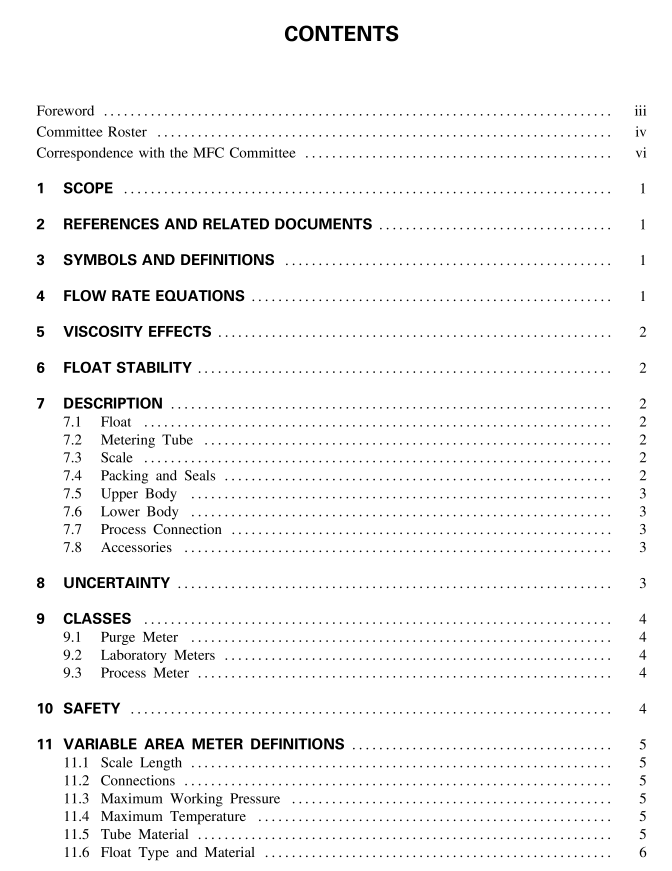ASME MFC-18M:2001 pdf free download MEASUREMENT OF FLUID FLOW USING VARIABLE AREA METERS
1 sCOPE
This Standard describes the common variable areaflowmeter. This Standard does not attempt to standardizedimensions because the commercial products differ toowidely.
The variable area meter is manufactured in a varietyof designs. This Standard addresses only those metersbased on a vertical tapered tube of round or a modifiedround cross section. Specifically not addressed are thevarious vane type meters,meters with horizontal flow,or meters which use a spring deflection to oppose flowforces.
REFERENCES AND RELATED DOcUMENTSASME MFC-1M Glossary of Terms Used in the Mea-surement of Fluid Flow in Pipes
ASME MFC-2M Measurement Uncertainty for FluidFlow in Closed Conduits
ASME Fluid Meters,6 th Ed
Publisher: The American Society of Mechanical Engi-neers (ASME),Three Park Avenue,New York,NY10016; Order Department: 22 Law Drive,Box 2300,Fairfield,NJ 07007-2300
3 SYMBOLS AND DEFINITIONS
For symbols and their definitions,see Table 1.
4FLoW RATE EQUATIONS
The variable area flowmeter is composed of a bodycontaining the fluid and a“float,” which is free tomove in the body to a position related to the flowrate. The balance of forces positions the float. Gravitypulls the float downward. The buoyancy of the floatplus the velocity related dynamic fluid forces lift thefloat. The float rises to increase the flow area until thefluid forces lifting the float match the downward force.The meter must be oriented with flow vertically upfor the analysis to be correct. Orientation substantially
off the vertical will cause errors or a failure to respond.(See ASME Fluid Meters for more complete analysisof the variable area meter).
lt is not practical to calculate meter capacity fromphysical principles for commercial variable area meters.The manufacturer’s catalogs do not list the tube crosssection areas,or float volumes,or weights,or inletand exit pressure drops; all of this information isproprietary. The manufacturer supplies all of the capac-ity data in the form of tables.This reduces the equationfor each meter flow to:
The full scale meter flow,C, is defined and tabulatedin the manufacturer’s catalogs for each specific meteringtube and float.Separate tables are used for liquids andcompressible fluids. The industry often uses the term“normal”[typical 1.013 bar and 20°C (14.7 psia and70°F)]conditions for compressible fluid sizing ratherthan“standard”. The user is cautioned to define thereference conditions used.(See the manufacturer’s litera-ture for guidance on sizing and calibration.) Equation2 shows how to correct for a float material densitydiffering from the basis density and for a flowing fluiddensity differing from the basis density:
NOTE: Use a consistent basis for SG. For compressible fluids,thenegative terms above become very small and are not significant.Calculate Mass flow as the product of volumetric flow and upstreammass density.
5 VISCOSITY EFFECTS
For variable area meters, a fluid viscosity exceeding the limit value or “viscosity ceiling”, or “viscosity immunity ceiling” as listed in the catalog tables for that specific tube and float, will affect the meter calibra- tion. In general, float designs with a sharp edge on the maximum diameter part of the float will be less sensitive to viscosity (See the manufacturer’s literature for guidance). In general, viscosity effects occur with fluids more viscous than water.
6 FLOAT STABILITY
The float may become unstable and “bob” up and down even at a constant flow (See the manufacturer’s catalogs for warnings and descriptions of this phenome- non). It is normally experienced only in low pressure gas service. Special floats are used to reduce this effect. Smaller flowmeters are more likely to be affected by this problem. These instabilities may be a result of a cyclic change between laminar and turbulent flow re- gimes or from fluid mechanical interactions.
7 DESCRIPTION
The variable area flowmeter (see Fig. 1 through Fig. 4) as described in this Standard is composed of:
(a) float
(b) metering tube
(c) scale
(d) packing and seals
(e) upper body
(f) lower body
(g) process connections
(h) accessories
ASME MFC-18M:2001 pdf free download
